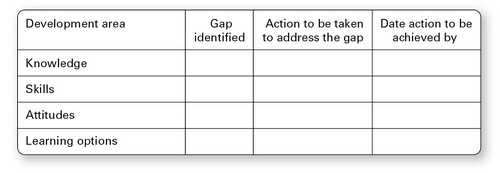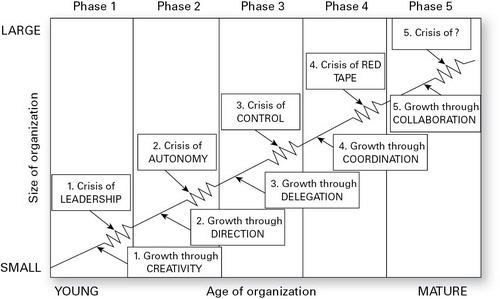Authors: Colin Barrow
The 30 Day MBA (31 page)
Two acronyms an MBA will find useful to pump-prime any development plan are the following.
KSAs (Knowledge, skills and attitudes)
Development programmes have learning objectives in each of these three areas and all three aspects need to be addressed for development to have the greatest impact:
- Knowledge, described as perception, learning and reasoning. Would it was as simple as that, but the HR and learning gurus have subdivided that into: declarative knowledge or factual information; procedural knowledge, that is, understanding how and when to apply the facts; and strategic knowledge, used in planning and evaluating.
- Skills are concerned with a proficiency level, for example in using a software application such as Excel, making a presentation, operating equipment, closing a sale or negotiating a deal.
- Attitudes are the positive, negative or neutral feelings arising out of opinions and beliefs concerning actions that affect motivation levels, which in turn influence a person's behaviour.
TNA (Training needs analysis)
This process identifies the gap between the skills an organization needs to achieve its strategic and tactical goals and the skills employees currently have. Employee surveys, management observations, customer comments and appraisal are all among the tools used to gather information to identify training needs. (See
Figure 4.11
.)
FIGURE 4.11
 Â
Training needs analysis worksheet

Organizations have a wide repertory of tools to apply to ensure that people are developed. Governments have an interest in encouraging training and often provide information on where training programmes are being run as well as offering grants to help with the costs. These should be explored at the outset, as any financial assistance can sweeten the budgetary pill. The main options in terms of learning methods are:
- On-the-job coaching and mentoring: This is where people learn from someone more experienced how a job should be done. The advantages are that it is free and involves no time away from work. It should also be directly related to an individual's training needs. However, it is only as good as the coach and if they are untrained you could end up simply replicating poor working standards.
- In-house classroom training: This is the most traditional and familiar form of training. Some, or all, of your employees gather in a âclassroom' either on your premises or in a local hotel. You hire in a trainer or use one of your own experienced staff. This method provides plenty of opportunity for group interaction and the instructor can motivate the class and pay some attention to individual needs. The disadvantages, particularly if it is held away from your premises, are that you incur large costs that are more to do with hospitality than training, it is time consuming and it may be difficult to release a large enough number of employees at the same time to achieve economies of scale.
- Public courses: These are less expensive than running a training programme in a hotel. You can also select different courses for different employees and so tailor the training more precisely to their needs. Most public courses are generic and the other attendees are more likely to come from big business or even the public sector. So, much of what is covered may be of little direct relevance to your business and quality can be patchy.
- Interactive distance learning: This kind of training can be delivered by a combination of traditional training materials, teleconferencing, internet and e-mail discussions. You miss out on the personal contact, but the costs are much lower than traditional training.
- Off-the-shelf training programmes: These come in packaged kits, which may consist of a training manual, video or a CD ROM. Once again the cost is lower than for face-to-face training, but you miss out on a professional trainer's input.
- Universities and colleges: Many universities and business schools now offer programmes tailored for the needs of the organization. Professional instructors who understand the needs of small firms deliver these. They are relatively expensive but can often be very effective.
- Business games, case studies and simulation exercises: A business game is virtually mandatory at some stage while taking an MBA. The game is constructed as a model, usually though not always software based, to simulate an entire company or industry or a particular functional area. They allow trainees working in teams to see how their decisions and actions influence a bigger picture. Outward Bound activities are also popular MBA development tools, using hazardous remote environments to create opportunities for conflict, leadership and the prospects of cohesion. These are also popular as elements in the management selection process.
Preparing for development
To make sure you get the best out of investment in development, follow these guidelines:
- Introduce a routine that ensures all employees attending training are briefed at least a week beforehand on what to expect and what is expected of them.
- Ensure that all employees discuss with their manager or supervisor what they got out of the training programme â in particular, did it meet both their expectations. This should take place no later than a week after the programme.
- Managers should check within a month and then again at regular intervals to see whether skills have been improved, and that those skills are being put into practice.
- Evaluate the costs and benefits of your training and development plans, arriving at financial ratio such as return on investment, and use this information to help set next year's training budget.
The story told in business schools to illustrate the dangers of ignoring the need for change is that of the hypothetical frog dropped into a pot of boiling water. The immediate impact of a radically different environment spurs the frog into action, leaping out of the pot. The same frog placed in the same pot, but where the initial temperature is much lower, will happily allow itself to be boiled to death, failing to recognize the danger if the process is slow enough.
The first task of a leader, therefore, is to define an organization's purpose and direction. This inevitably means changing those in response to changing circumstances.
Why change is necessary
The need for change comes from two main directions: either a new impetus from outside or inside the organization; or from the natural evolution of the organization itself.
Impetus-driven change
These are the primary sources of the impetus for change that disturb the equilibrium of an organization:
- New management: This doesn't always trigger change but the temptation to tamper with even the best of organizations is usually too much for a ânew broom'. The person appointed almost invariably will want to put their stamp on strategy and structure; if all was really so hunky-dory, why appoint them in the first place?
- Competitor behaviour: This can be either new entrants or existing players changing the dynamics in your markets by competing with better products, lower prices or smarter operations.
- Technology: Changes here can hit whole business sectors. For example, the advent initially of online DVD services and more recently of broadband delivery has profoundly changed the environment for the retail video rental business.
- Economic, political or legal environment: These include such factors as: business cycles altering demand levels radically; changes of government with consequent shifts in expenditure and taxation; and regulatory changes such as those affecting the tobacco industry and its ability to promote its wares.
Natural evolution
Organizations are in some ways like living organisms and have a natural progression from birth through childhood, adolescence, adulthood, senility and death. Some stages in the process for an organization are easily recognizable. All have a start and finish date and though their life span varies, for businesses at least, the average is around 35 to 38 years. Some last much longer; there is a small club for businesses who have been around for over 250 years. (Japan's 1,400-year-old Kongo Gumi may be the oldest business enterprise, but guns (Beretta), banking (Rothschild) and booze (the Gekkeikan brewery founded in 1627) also feature strongly (see âBusiness history').)
The phases of growth
Larry Greiner, a Harvard professor, identified the key phases an organization has to go through in its path to maturity. (See
Figure 4.12
.) Churchill and Lewis (Churchill, N C and Lewis, V L (1983) âThe Five Stages of Small Business Growth',
Harvard Business Review
, May/June) refined this for small businesses.
FIGURE 4.12
 Â
The five phases of growth

SOURCE:
L E Greiner,
Harvard Business Review
, July/August
1972
.
Each phase of growth calls for a different approach to managing the organization. Sometimes strong leadership is required; at others a more consultative approach is appropriate. Some phases call for more systems and procedures, some for more cooperation between staff. Often leaders
believe that taking on another salesperson, a few hundred thousand square metres of space or another bank loan can solve the problems of growing up. This approach is rather like suggesting that the transition from infancy to adulthood could be accomplished by nothing more significant than providing larger clothes.
Managing the process
Because change is inevitable and unpredictable in its consequences doesn't mean that it can't be managed as a process. These are the stages in managing change:
- Tell them why: Change is better accepted when people are given a compelling business reason. Few bankers would question the need for change after the 2008 debacles at Bear Stearns, SocGen and Northern Rock.
- Make it manageable: Even when people accept what needs to be done, the change may just be too big for anyone to handle. Breaking it down into manageable bits can help overcome this.
- Take a shared approach: Involve people early, asking them to join you in managing change, and give key participants some say in shaping the change right from the start. This will reduce the feeling that change is being imposed and more brains will be brought to bear on the problem.
- Reward success early: Flag up successes as quickly as possible. Don't wait for the year-end or the appraisal cycle. This will inspire confidence and keep the change process on track.
- Expect resistance: Kurt Lewin, a German-born professor at the Massachusetts Institute of Technology (MIT), was one of the first researchers to study group dynamics and how change can be best effected in organizations. In 1943 in an article entitled âDefining the Field at a Given Time' published in the
Psychological Review
, Lewin described what is now known as Force Field Analysis. This is a tool (see
Figure 4.13
) that you can use to anticipate resistance to change and plan to overcome it. - Recognize that change takes longer than expected: Three researchers (Adams, J, Hayes, J and Hopson, B) explained in
Transition: Understanding and Managing Personal Change
(1976, Martin Robinson, London) the six stages that people go through when experiencing change and hence the reason the process takes so long. The stages are: immobilization or shock, disbelief, depression, acceptance of reality, testing out the new situation, rationalizing why it's happening and then final acceptance. Most major changes make things worse before they make them better. More often than not, the immediate impact of change is a decrease in productivity as people struggle to cope with new ways of working while they move up their own learning curve. The doubters will gloat and even the change champions may waver. But the greatest danger now is pulling the plug on the plan and either adopting a new plan or reverting to the status quo. To prevent this âdisappointment' it is vital both to set realistic goals for the change period and to anticipate the time lag between change and results.